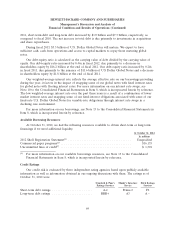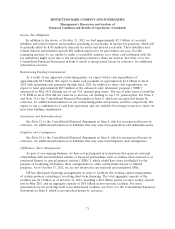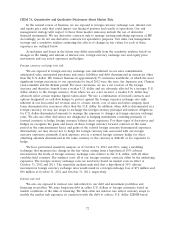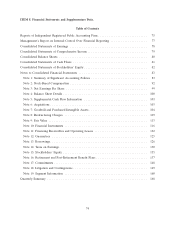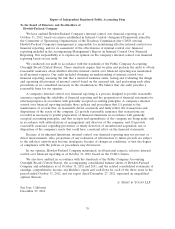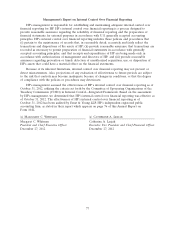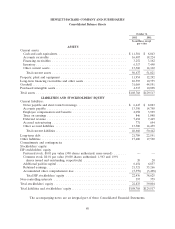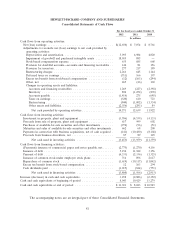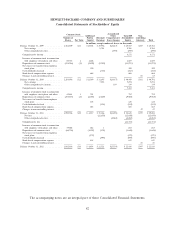HP 2012 Annual Report Download - page 81
Download and view the complete annual report
Please find page 81 of the 2012 HP annual report below. You can navigate through the pages in the report by either clicking on the pages listed below, or by using the keyword search tool below to find specific information within the annual report.floating interest expense. The swap transactions generally involve the exchange of fixed for floating
interest payments. However, we may choose not to swap fixed for floating interest payments or may
terminate a previously executed swap if we believe a larger proportion of fixed-rate debt would be
beneficial. In order to hedge the fair value of certain fixed-rate investments, we may enter into interest
rate swaps that convert fixed interest returns into variable interest returns. We may use cash flow
hedges to hedge the variability of LIBOR-based interest income received on certain variable-rate
investments. We may also enter into interest rate swaps that convert variable rate interest returns into
fixed-rate interest returns.
We have performed sensitivity analyses as of October 31, 2012 and 2011, using a modeling
technique that measures the change in the fair values arising from a hypothetical 10% adverse
movement in the levels of interest rates across the entire yield curve, with all other variables held
constant. The analyses cover our debt, investment instruments, financing receivables and interest rate
swaps. The analyses use actual or approximate maturities for the debt, investments, interest rate swaps
and financing receivables. The discount rates we used were based on the market interest rates in effect
at October 31, 2012 and 2011. The sensitivity analyses indicated that a hypothetical 10% adverse
movement in interest rates would result in a loss in the fair values of our debt, investment instruments
and financing receivables, net of interest rate swap positions, of $121 million at October 31, 2012 and
$145 million at October 31, 2011.
Equity price risk
We are also exposed to equity price risk inherent in our portfolio of publicly traded equity
securities, which had an estimated fair value of $59 million at October 31, 2012 and $118 million at
October 31, 2011. We monitor our equity investments for impairment on a periodic basis. Generally, we
do not attempt to reduce or eliminate our market exposure on these equity securities. However, we
may use derivative transactions to hedge certain positions from time to time. We do not purchase our
equity securities with the intent to use them for speculative purposes. A hypothetical 30% adverse
change in the stock prices of our publicly traded equity securities would result in a loss in the fair
values of our marketable equity securities of approximately $18 million and $35 million at October 31,
2012 and 2011, respectively. The aggregate cost of investments in privately-held companies, and other
investments was $59 million at October 31, 2012 and $57 million at October 31, 2011.
73








